This blog post reports on work-in-progress within the DfG course! The post is written by group 2C working with the Ministry of Transport and Communication’s brief on ‘Accessible travel chains’. The group includes Callisté Mastrandreas from the CS Design program, Jingchun Zeng from the CoID program, Greta Cappellini from the CS Design exchange program, and Sara Rynefors from the CS Design program.
Written by: Jingchun Zeng
When putting together the puzzle, we always try to find a special piece from tons of them, the perfect one, the one with semi-round shapes to reach in all four directions. When thinking about our proposal for having accessible travel chains, we Urban Drifters felt were putting together a large puzzle. Different service providers, various users’ needs and complex transportation systems felt like piles of pieces to us. Before introducing what we found in the end, let’s take a small step back and see what the Urban Drifters have done in May to find the missing puzzle piece in accessible travel chains.
Let’s stand back to see the whole picture: Where is the missing piece?
Three weeks have passed since our last update about our process. During this time, we were trying to finalize our proposal and validating with our stakeholders. As our last blog described, we gave a new definition of what an accessible public travel chain is. An accessible travel chain should be friendly to every user in every season, from their doors to their final destination. We noticed that the frequency of people with reduced mobility using public transportation dramatically decreased in Winter. By going through all of our interview data, desk research and case studies, highlighting the difficulties stakeholders and users mentioned and imagining the future version of the accessible travel chain they want, a picture gradually became clear in our minds – the streets were missing. If there’s no one to represent the streets as part of the public travel chain, the whole picture will fall apart and the street will become the first barrier for users to access the travel chain. But, how might we lower the threshold for all the citizens to better experience the public travel chain? How might we ensure that door-to-door travels are accessible during the whole year and for every user?
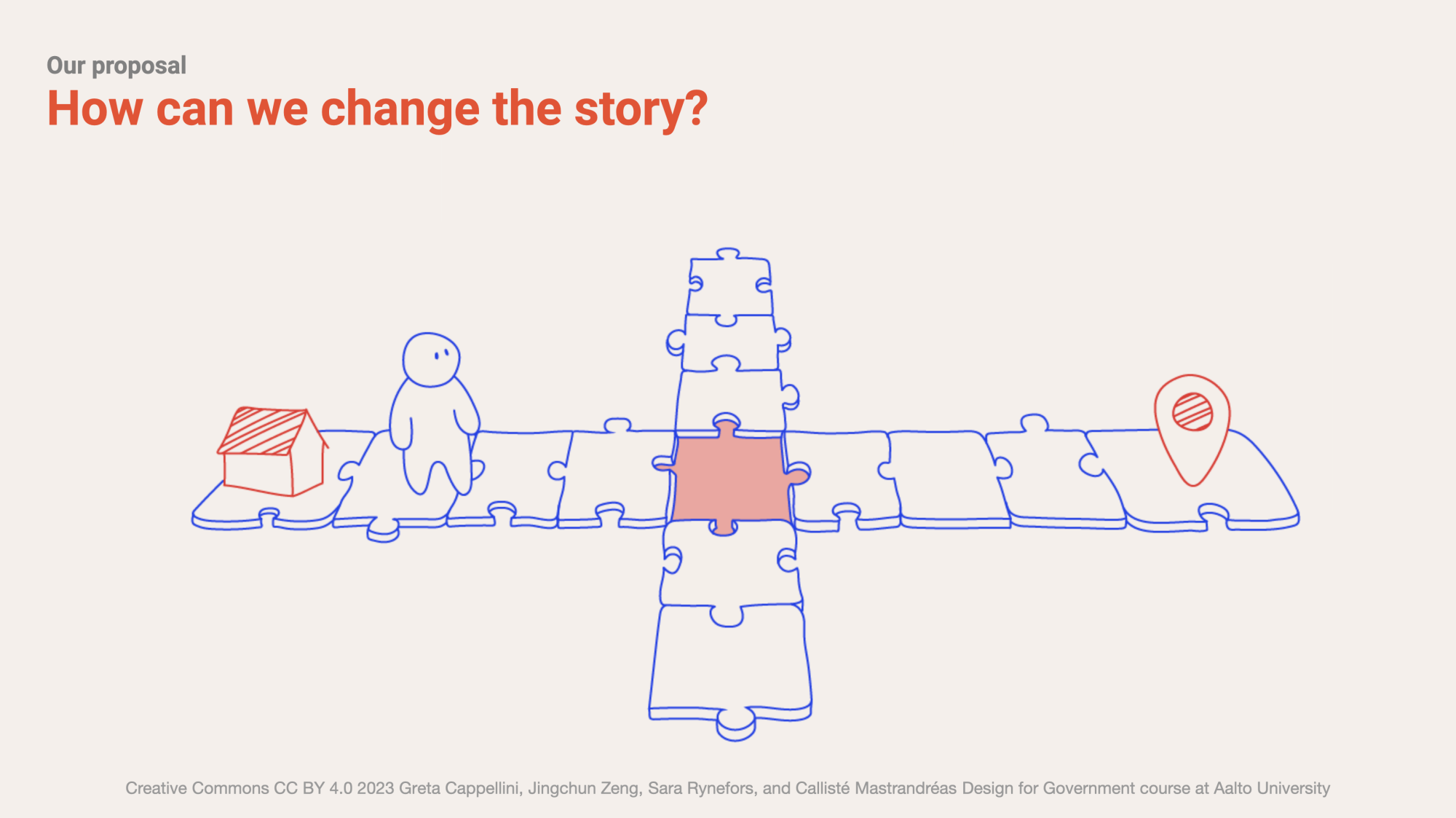
Aha! Find the missing piece of the puzzle!
In an ideation session we conducted with our stakeholders, we noticed that priority is not given to the streets and pedestrians. Who is responsible for which part of the street is not clearly defined, and some street owners think maintaining streets is not vital. Making use of Meadows’ leverage points definition (1999), we realized that if we wanted to include the streets in the accessible public travel chain, we needed to find the actions connected to interventions we discovered in order to evolve and self-organized the whole system structure. We wanted to find out how to make sure the good maintenance of the streets, how to provide accessibility to users on their daily trips and how to provide motivation for stakeholders to join our proposal became our biggest challenges.
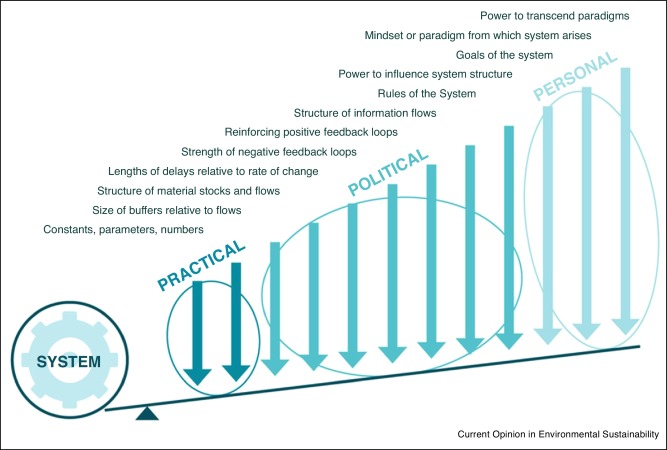
Looking at Meadows’ fourth leverage point, the power to influence system structure, we had our “aha” moment. All this time, we have been trying to make every service provider responsible for different streets rather than thinking about who can be the one especially responsible for the streets. By reanalyzing the relationship between different service providers, we came up with an idea: What if we were to have a task force to connect the stakeholders, contractors and users? What if we were to provide a service provider to our stakeholders?
The Task force – a new node of information
When discussing the benefits of including users in the early stage of policy making and applying design approaches to policy making, Kimbell (2015) points out that the insights from people’s own experiences can provide opportunities to challenge the existing systems. She highlights the case of policy labs, and how they help reach out to policy-makers, enhancing cooperation and exploring new models.
“Policy Lab’s expertise is in taking a structured creative and analytical approach, not in a policy area. It gives civil servants experiences of practical inquiries and methods which explore and frame problems and generate and iterate solutions.”
– Kimbell, 2015
In our proposal, we create a new information node to connect the users and service providers – The Task force. Like Kimbell’s policy lab, the aim of The Task force is to integrate the streets as part of the public travel chain, which will be within Helsinki’s, Vantaa’s and Espoo’s Department of road management and work in close collaboration with different transport service providers, contractors and users.
Our proposal consists of seven key phases – creating the task force, setting the high-level standards of accessible streets, defining the trips in the pilot project, adapting contracts with stakeholders, piloting, getting feedback, and iterating. Through this, we highly encourage our partners to hear users’ voices in the early stage of setting high-level standards of accessible streets. To implement The Task force, the ministry could allocate the funding to facilitate the pilot project and municipalities can organize The Task force’s collaborative aspect to involve service providers and user representatives in a series of workshops as soon as possible. In addition, when setting the high-level standard of accessible streets with users and service providers, the collaboration model between stakeholders and precise requirements for bike lanes in Oulu can be considered as a guideline to set standards. And to collect users’ feedback, the existing tools Digitransit and Digiroad can be used and expanded to collect both quantitative and qualitative data.
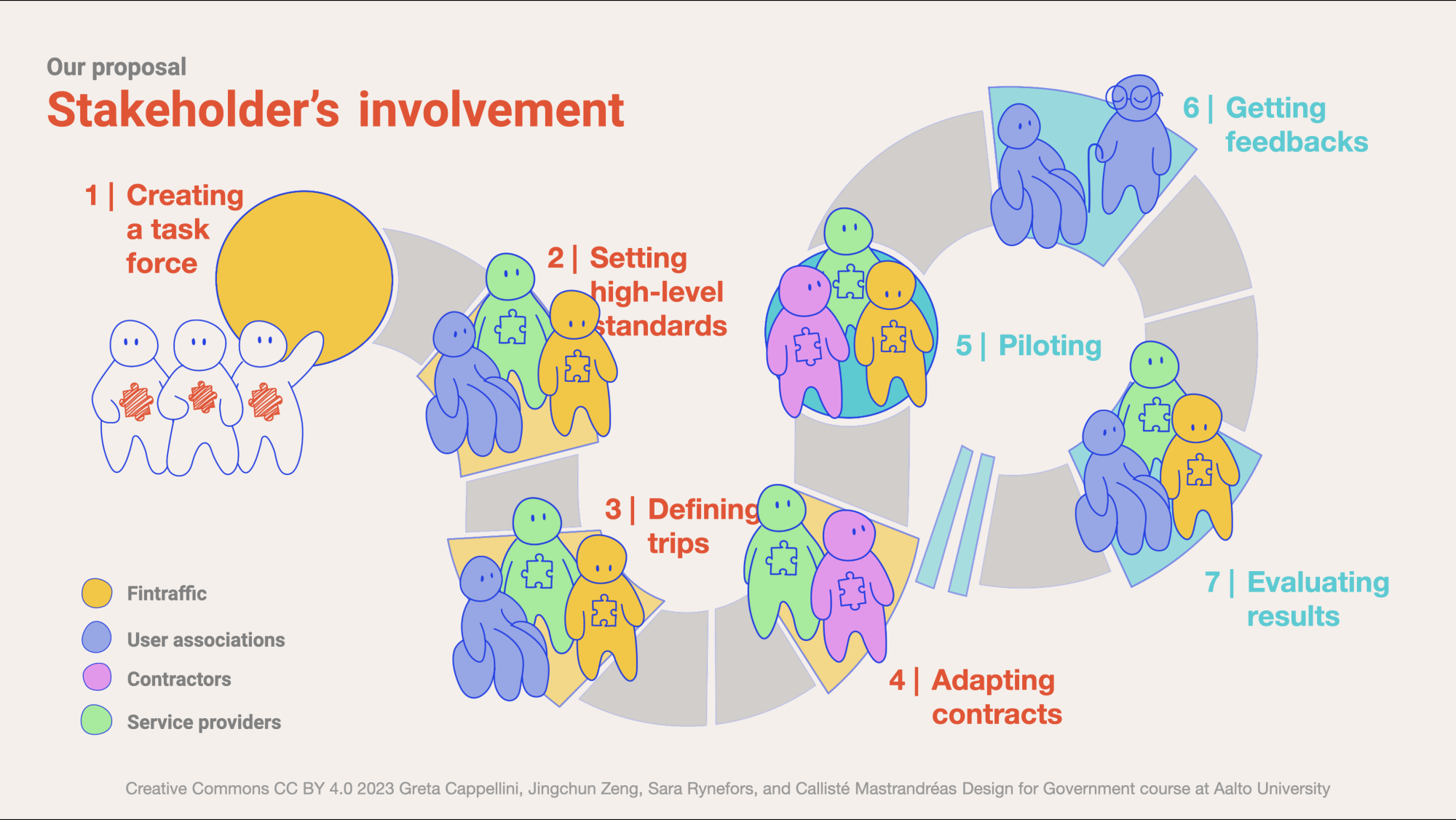
Small change, big impact.
“In a complex system, when you change one thing, you change many things.”
– Ramboll, mobility Specialist
To achieve an accessible travel chain, we attach importance to the streets. We want to make sure that the first and last mile of every user’s journey is accessible, no matter whether they are people with reduced mobility, the elderly or people with small children. By involving users and service providers in the phase of setting high-level standards of accessible streets through The Task force, the priority will be shifted from vehicles to pedestrians. By making use of different campaigns for users to define their favorite trips in the pilot project, a sense of belonging can be created. Because of the existence of The Task force, the transparent system will decrease users’ worry, encouraging them to participate in the pilots, and creating a win-win situation.
Inspired by one of our stakeholders, we proposed the pilot project between Helsinki, Espoo and Vantaa, a special area with a close relationship among the three cities. When the pilot project receives a success, the task force can be applied to other countries in Finland and gradually expanded into a national level.
Streets Ahead!
By the time you read this blog, the 2023 DfG drew to a successful ending, but I believe it will not be the final ending. On the day of the final show, our partners were excited about every group’s proposal. Though accomplishing accessible travel chains will still require work to be achieved, our proposals gave them new ideas and new directions. We may see more cooperation between different service providers, designers and users in the near future.
On behalf of Urban Drifters, I would like to thank you our project partners the Ministry of Transport and Communications, as well as other stakeholders who share with us their time and knowledge. And also thank you to the teaching team of Design for Government, who are always by our side, warm and kind. And last but not least, shout out to my lovely drifters who always supported me! ❤️
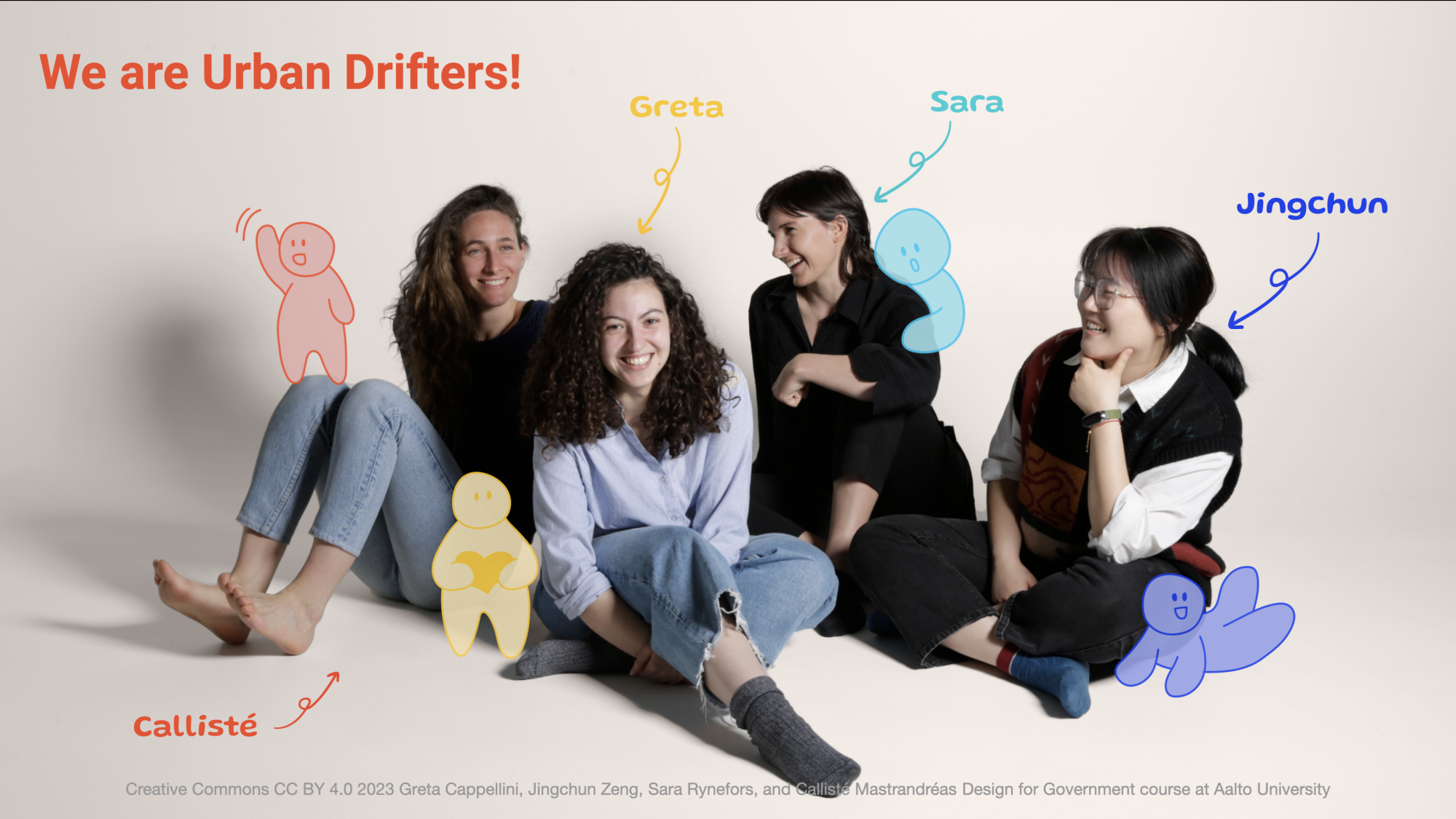
Looking forward to meeting you on the street,
Urban Drifters 😉
References:
Kimbell, L. (2015). Applying design approaches to policy making: discovering policy lab.
Meadows, D. H. (1999). Leverage points: Places to intervene in a system.
The DfG course runs for 14 weeks each spring – the 2023 course has now started and runs from 27 Feb to 31 May. It’s an advanced studio course in which students work in multidisciplinary teams to address project briefs commissioned by governmental ministries in Finland. The course proceeds through the spring as a series of teaching modules in which various research and design methods are applied to address the project briefs. Blog posts are written by student groups, in which they share news, experiences and insights from within the course activities and their project development. More information here about the DfG 2023 project briefs.

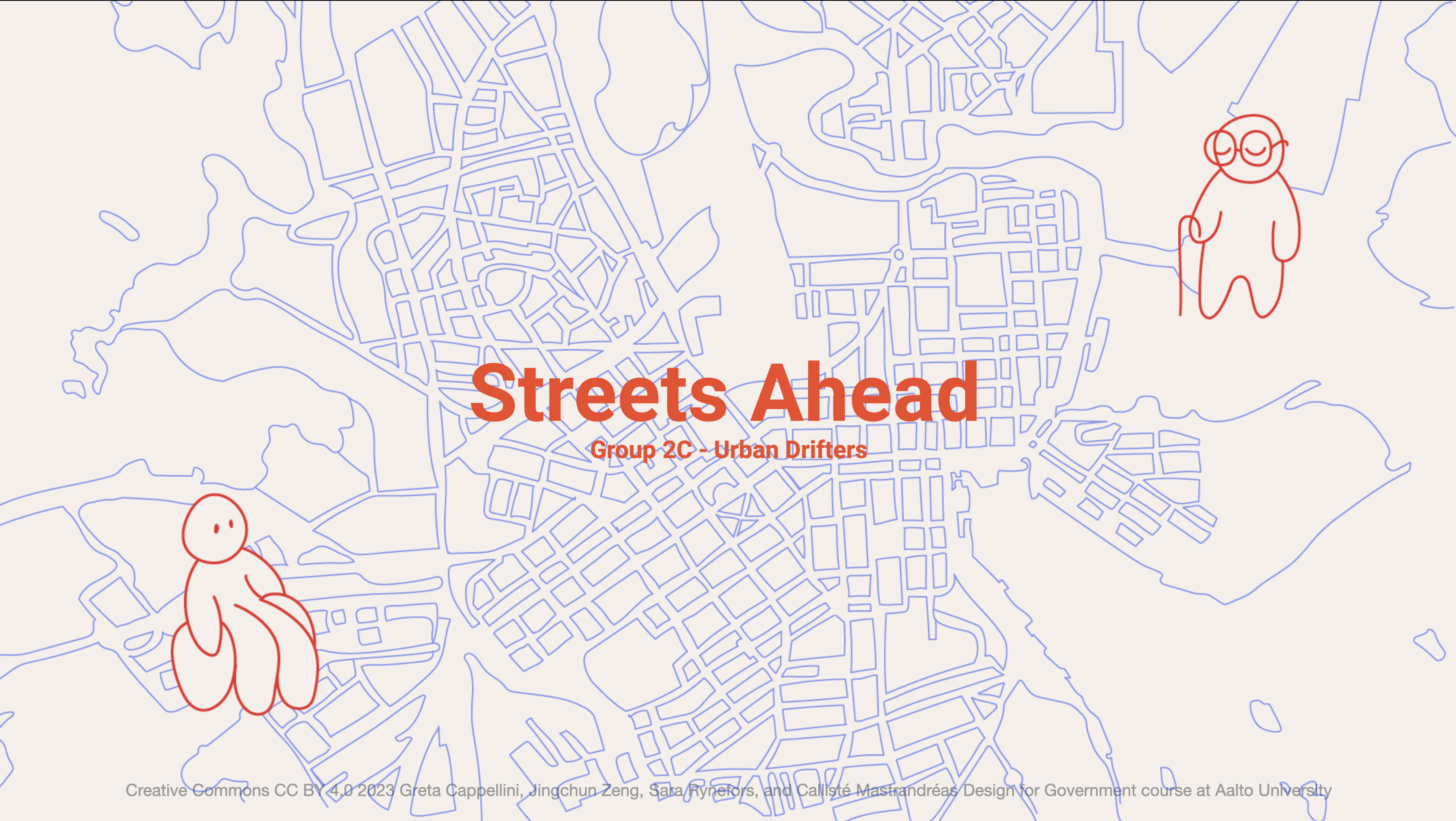
Could you describe the process that Urban Drifters undertook in May to address the concept of accessible travel chains? How did you approach the challenge of integrating different service providers, accommodating various user needs, and navigating complex transportation systems to create a coherent proposal? Additionally, what were the key findings or insights that emerged from your efforts?